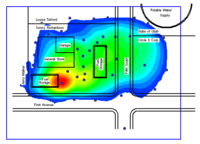|
|
| Line 12: |
Line 12: |
|
| |
|
| == Interpolation Method == | | == Interpolation Method == |
| The following 2D [[GMS:Interpolation|interpolation methods]] are supported by GMS:
| | {{GMS 2D Interpolation Method}} |
| | |
| *[[GMS:Linear|Linear]]
| |
| *[[GMS:Inverse Distance Weighted|Inverse Distance Weighted]]
| |
| *[[GMS:Clough-Tocher|Clough-Tocher]]
| |
| *[[GMS:Natural Neighbor|Natural Neighbor]]
| |
| *[[GMS:Kriging|Kriging]]
| |
|
| |
|
| {{Navbox GMS}} | | {{Navbox GMS}} |
| [[Category:2D Scatter Point]] | | [[Category:2D Scatter Point]] |
| {{stub}} | | {{stub}} |
Scatter point sets are used for interpolation to other data types such as TINs, grids, and meshes.
Interpolation is useful for such tasks as contouring or setting up input data to a model. Since no interpolation scheme is superior in all cases, several interpolation techniques are provided in GMS.
The basic approach to performing an interpolation is to select an appropriate interpolation scheme and interpolation parameters, and then interpolate to the desired object using one of the 2D Interpolation Commands.
The interpolation options are selected using the Interpolation Options dialog accessed through the Interpolation Options command in the Interpolation menu. Once a set of options is selected, those options are used for all subsequent interpolation commands.
A 2D grid can be created which will enclose the scatter points by using the Bounding 2D Grid command in the Scatter Points menu. A 3D grid can also be created using the Bounding 3D Grid command in the Scatter Points menu.
Interpolation Method
The following 2D interpolation methods are supported by GMS:
- Linear – Uses data points that are first triangulated to form a network of triangles.
- Inverse Distance Weighted – Based on the assumption that the interpolating surface should be influenced most by the nearby points and less by the more distant points.
- Clough-Tocher – A finite element method because it has origins in the finite element method of numerical analysis.
- Natural Neighbor – Based on the Thiessen polygon network of the point data.
- Kriging – Based on the assumption that the parameter being interpolated can be treated as a regionalized variable.
Log interpolation is also supported.
